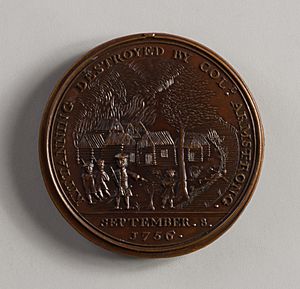Kittanning Expedition facts for kids
Quick facts for kids Kittanning Expedition |
|||||||
|---|---|---|---|---|---|---|---|
| Part of the French and Indian War | |||||||
|
|||||||
| Belligerents | |||||||
| Delaware Indians | |||||||
| Commanders and leaders | |||||||
| John Armstrong | Captain Jacobs † | ||||||
| Strength | |||||||
| 300 provincial soldiers | Unknown | ||||||
| Casualties and losses | |||||||
| 17 killed 13 wounded 19 missing (the missing include 4 liberated white prisoners, 2 of whom were recaptured and killed) |
7 men and 2 women killed | ||||||
The Kittanning Expedition was a surprise attack during the French and Indian War. It is also called the Armstrong Expedition or the Battle of Kittanning. This event led to the destruction of the Native American village of Kittanning. The village was a base for Delaware warriors. They launched attacks against settlers in the British Province of Pennsylvania.
Lieutenant Colonel John Armstrong led this raid. It was a major trip deep into enemy land. It was the only big expedition by Pennsylvania soldiers during a tough frontier war. On September 8, 1756, they launched a surprise attack on the village.
Why the Expedition Happened
The French and Indian War started as a fight for control of the Ohio Country. This area is in what is now the midwestern United States. In 1754, George Washington surrendered at Fort Necessity. Then, in 1755, General Edward Braddock was defeated. This left settlers in Pennsylvania without military protection. They had to quickly organize their own defense.
Native American groups allied with the French had defeated General Braddock. These groups were mostly from the Great Lakes region. Local Native Americans, mainly Delaware and Shawnee, had moved to the area. They had waited to see who would win the fight between the French and British. After the French secured Fort Duquesne, they encouraged the Delaware and Shawnee to fight the British.
Around October 1755, Delaware and Shawnee war parties began raiding settlements in Pennsylvania. They often worked with the French. Two important Delaware war leaders were Shingas and Captain Jacobs. Both lived in Kittanning. The governments of Pennsylvania and Virginia offered rewards for their capture.
Captain Jacobs was part of an attack on Fort Granville in August 1756. The fort's commander was killed, and the fort surrendered. The commander's brother, Lieutenant Colonel John Armstrong, quickly planned an expedition against Kittanning in response.
The Surprise Attack
On August 31, John Armstrong led 300 Pennsylvania soldiers from Fort Shirley. By September 7, they were close to Kittanning. They saw signs of a small Native American camp. Armstrong sent a dozen men to watch it. The main group continued towards the village.
The next morning, Armstrong launched a surprise attack. Many Kittanning residents ran away. But Captain Jacobs fought back. He, his wife, and family stayed inside their home. When he refused to give up, his house and others were set on fire. Gunpowder stored inside exploded. Captain Jacobs was killed trying to escape the flames. The battle ended when the whole village was on fire.
Prisoners told Armstrong that 24 men had left the day before for another raid. This worried Armstrong about the men he had sent to watch the camp. He quickly ordered his troops to leave. After a few miles, they met a badly wounded Lieutenant Hogg. He reported that his group had been attacked by a larger Native American force. Some of his men had run away, and most of the rest were killed. By September 13, Armstrong and his remaining force returned to Fort Loudon.
Armstrong reported that he freed 11 prisoners, mostly women and children. He estimated his men killed between 30 and 40 Native Americans. Many white captives who were not rescued were taken across the Allegheny River. They then traveled into Ohio and became part of the tribes. Many were not rescued until 1764.
What Happened Next
After the village was destroyed, some residents returned. They built new homes on the ashes of their old ones. The town was briefly reoccupied. Two English prisoners who tried to escape with Armstrong's men were killed. The Native Americans then harvested their corn. They moved to Fort Duquesne and asked the French to resettle further west. Many of Kittanning's people moved to places like Saucunk, Kuskusky, or Muskingum.
The destruction of Kittanning was seen as a victory in Pennsylvania. Armstrong became known as the "Hero of Kittanning." He and his men collected a reward for Captain Jacobs. However, the victory had limits. The attackers had more casualties than the Native Americans. Most villagers escaped, taking almost all the prisoners with them.
The expedition also made the frontier war worse. Native American raids that autumn were more intense than before. The Kittanning raid showed the villagers they were not safe. Many moved to more secure areas. A group wanting peace, led by Shingas's brother Tamaqua, soon became important. Tamaqua later made peace with Pennsylvania in the Treaty of Easton. This peace helped the British, led by General John Forbes, to successfully drive the French from Fort Duquesne in 1758.
See also
 In Spanish: Expedición Kittanning para niños
In Spanish: Expedición Kittanning para niños


